+ Open data
Open data
- Basic information
Basic information
| Entry | Database: EMDB / ID: EMD-8962 | |||||||||
|---|---|---|---|---|---|---|---|---|---|---|
| Title | Cryo-EM structure of rat TRPV6 in complex with Calmodulin | |||||||||
 Map data Map data | primary map | |||||||||
 Sample Sample |
| |||||||||
 Keywords Keywords | TRPV6 / TRP channels / Calcium channels / MEMBRANE PROTEIN | |||||||||
| Function / homology |  Function and homology information Function and homology informationparathyroid hormone secretion / TRP channels / calcium-activated cation channel activity / calcium ion import / CaM pathway / Cam-PDE 1 activation / Sodium/Calcium exchangers / Calmodulin induced events / Reduction of cytosolic Ca++ levels / Activation of Ca-permeable Kainate Receptor ...parathyroid hormone secretion / TRP channels / calcium-activated cation channel activity / calcium ion import / CaM pathway / Cam-PDE 1 activation / Sodium/Calcium exchangers / Calmodulin induced events / Reduction of cytosolic Ca++ levels / Activation of Ca-permeable Kainate Receptor / CREB1 phosphorylation through the activation of CaMKII/CaMKK/CaMKIV cascasde / Loss of phosphorylation of MECP2 at T308 / CREB1 phosphorylation through the activation of Adenylate Cyclase / CaMK IV-mediated phosphorylation of CREB / PKA activation / negative regulation of high voltage-gated calcium channel activity / Glycogen breakdown (glycogenolysis) / CLEC7A (Dectin-1) induces NFAT activation / Activation of RAC1 downstream of NMDARs / negative regulation of ryanodine-sensitive calcium-release channel activity / organelle localization by membrane tethering / mitochondrion-endoplasmic reticulum membrane tethering / autophagosome membrane docking / negative regulation of calcium ion export across plasma membrane / regulation of cardiac muscle cell action potential / presynaptic endocytosis / Synthesis of IP3 and IP4 in the cytosol / regulation of cell communication by electrical coupling involved in cardiac conduction / Phase 0 - rapid depolarisation / calcineurin-mediated signaling / Negative regulation of NMDA receptor-mediated neuronal transmission / Unblocking of NMDA receptors, glutamate binding and activation / RHO GTPases activate PAKs / Ion transport by P-type ATPases / Uptake and function of anthrax toxins / calcium ion import across plasma membrane / regulation of ryanodine-sensitive calcium-release channel activity / Long-term potentiation / protein phosphatase activator activity / Calcineurin activates NFAT / Regulation of MECP2 expression and activity / DARPP-32 events / catalytic complex / Smooth Muscle Contraction / detection of calcium ion / regulation of cardiac muscle contraction / RHO GTPases activate IQGAPs / regulation of cardiac muscle contraction by regulation of the release of sequestered calcium ion / cellular response to interferon-beta / calcium ion homeostasis / Protein methylation / calcium channel inhibitor activity / Activation of AMPK downstream of NMDARs / presynaptic cytosol / Ion homeostasis / regulation of release of sequestered calcium ion into cytosol by sarcoplasmic reticulum / eNOS activation / titin binding / Tetrahydrobiopterin (BH4) synthesis, recycling, salvage and regulation / sperm midpiece / regulation of calcium-mediated signaling / voltage-gated potassium channel complex / calcium channel complex / substantia nigra development / FCERI mediated Ca+2 mobilization / Ras activation upon Ca2+ influx through NMDA receptor / regulation of heart rate / FCGR3A-mediated IL10 synthesis / calyx of Held / Antigen activates B Cell Receptor (BCR) leading to generation of second messengers / adenylate cyclase activator activity / sarcomere / regulation of cytokinesis / VEGFR2 mediated cell proliferation / protein serine/threonine kinase activator activity / VEGFR2 mediated vascular permeability / spindle microtubule / Translocation of SLC2A4 (GLUT4) to the plasma membrane / calcium channel regulator activity / positive regulation of receptor signaling pathway via JAK-STAT / Stimuli-sensing channels / RAF activation / Transcriptional activation of mitochondrial biogenesis / response to calcium ion / calcium ion transmembrane transport / calcium channel activity / RAS processing / cellular response to type II interferon / G2/M transition of mitotic cell cycle / long-term synaptic potentiation / spindle pole / Signaling by RAF1 mutants / Signaling by moderate kinase activity BRAF mutants / Paradoxical activation of RAF signaling by kinase inactive BRAF / Signaling downstream of RAS mutants / calcium-dependent protein binding / calcium ion transport / Signaling by BRAF and RAF1 fusions / Inactivation, recovery and regulation of the phototransduction cascade / Platelet degranulation Similarity search - Function | |||||||||
| Biological species |  Homo sapiens (human) / Homo sapiens (human) /  | |||||||||
| Method | single particle reconstruction / cryo EM / Resolution: 3.6 Å | |||||||||
 Authors Authors | Singh AK / McGoldrick LL | |||||||||
| Funding support |  United States, 1 items United States, 1 items
| |||||||||
 Citation Citation |  Journal: Sci Adv / Year: 2018 Journal: Sci Adv / Year: 2018Title: Mechanism of calmodulin inactivation of the calcium-selective TRP channel TRPV6. Authors: Appu K Singh / Luke L McGoldrick / Edward C Twomey / Alexander I Sobolevsky /  Abstract: Calcium (Ca) plays a major role in numerous physiological processes. Ca homeostasis is tightly controlled by ion channels, the aberrant regulation of which results in various diseases including ...Calcium (Ca) plays a major role in numerous physiological processes. Ca homeostasis is tightly controlled by ion channels, the aberrant regulation of which results in various diseases including cancers. Calmodulin (CaM)-mediated Ca-induced inactivation is an ion channel regulatory mechanism that protects cells against the toxic effects of Ca overload. We used cryo-electron microscopy to capture the epithelial calcium channel TRPV6 (transient receptor potential vanilloid subfamily member 6) inactivated by CaM. The TRPV6-CaM complex exhibits 1:1 stoichiometry; one TRPV6 tetramer binds both CaM lobes, which adopt a distinct head-to-tail arrangement. The CaM carboxyl-terminal lobe plugs the channel through a unique cation-π interaction by inserting the side chain of lysine K115 into a tetra-tryptophan cage at the pore's intracellular entrance. We propose a mechanism of CaM-mediated Ca-induced inactivation that can be explored for therapeutic design. | |||||||||
| History |
|
- Structure visualization
Structure visualization
| Movie |
 Movie viewer Movie viewer |
|---|---|
| Structure viewer | EM map:  SurfView SurfView Molmil Molmil Jmol/JSmol Jmol/JSmol |
| Supplemental images |
- Downloads & links
Downloads & links
-EMDB archive
| Map data |  emd_8962.map.gz emd_8962.map.gz | 49.7 MB |  EMDB map data format EMDB map data format | |
|---|---|---|---|---|
| Header (meta data) |  emd-8962-v30.xml emd-8962-v30.xml emd-8962.xml emd-8962.xml | 17.4 KB 17.4 KB | Display Display |  EMDB header EMDB header |
| Images |  emd_8962.png emd_8962.png | 107.7 KB | ||
| Filedesc metadata |  emd-8962.cif.gz emd-8962.cif.gz | 6.8 KB | ||
| Archive directory |  http://ftp.pdbj.org/pub/emdb/structures/EMD-8962 http://ftp.pdbj.org/pub/emdb/structures/EMD-8962 ftp://ftp.pdbj.org/pub/emdb/structures/EMD-8962 ftp://ftp.pdbj.org/pub/emdb/structures/EMD-8962 | HTTPS FTP |
-Validation report
| Summary document |  emd_8962_validation.pdf.gz emd_8962_validation.pdf.gz | 556.8 KB | Display |  EMDB validaton report EMDB validaton report |
|---|---|---|---|---|
| Full document |  emd_8962_full_validation.pdf.gz emd_8962_full_validation.pdf.gz | 556.1 KB | Display | |
| Data in XML |  emd_8962_validation.xml.gz emd_8962_validation.xml.gz | 6.1 KB | Display | |
| Data in CIF |  emd_8962_validation.cif.gz emd_8962_validation.cif.gz | 7 KB | Display | |
| Arichive directory |  https://ftp.pdbj.org/pub/emdb/validation_reports/EMD-8962 https://ftp.pdbj.org/pub/emdb/validation_reports/EMD-8962 ftp://ftp.pdbj.org/pub/emdb/validation_reports/EMD-8962 ftp://ftp.pdbj.org/pub/emdb/validation_reports/EMD-8962 | HTTPS FTP |
-Related structure data
| Related structure data |  6e2gMC  8961C  6e2fC M: atomic model generated by this map C: citing same article ( |
|---|---|
| Similar structure data |
- Links
Links
| EMDB pages |  EMDB (EBI/PDBe) / EMDB (EBI/PDBe) /  EMDataResource EMDataResource |
|---|---|
| Related items in Molecule of the Month |
- Map
Map
| File |  Download / File: emd_8962.map.gz / Format: CCP4 / Size: 52.7 MB / Type: IMAGE STORED AS FLOATING POINT NUMBER (4 BYTES) Download / File: emd_8962.map.gz / Format: CCP4 / Size: 52.7 MB / Type: IMAGE STORED AS FLOATING POINT NUMBER (4 BYTES) | ||||||||||||||||||||||||||||||||||||||||||||||||||||||||||||||||||||
|---|---|---|---|---|---|---|---|---|---|---|---|---|---|---|---|---|---|---|---|---|---|---|---|---|---|---|---|---|---|---|---|---|---|---|---|---|---|---|---|---|---|---|---|---|---|---|---|---|---|---|---|---|---|---|---|---|---|---|---|---|---|---|---|---|---|---|---|---|---|
| Annotation | primary map | ||||||||||||||||||||||||||||||||||||||||||||||||||||||||||||||||||||
| Projections & slices | Image control
Images are generated by Spider. | ||||||||||||||||||||||||||||||||||||||||||||||||||||||||||||||||||||
| Voxel size | X=Y=Z: 1.06 Å | ||||||||||||||||||||||||||||||||||||||||||||||||||||||||||||||||||||
| Density |
| ||||||||||||||||||||||||||||||||||||||||||||||||||||||||||||||||||||
| Symmetry | Space group: 1 | ||||||||||||||||||||||||||||||||||||||||||||||||||||||||||||||||||||
| Details | EMDB XML:
CCP4 map header:
| ||||||||||||||||||||||||||||||||||||||||||||||||||||||||||||||||||||
-Supplemental data
- Sample components
Sample components
-Entire : TRPV6-Calmodulin
| Entire | Name: TRPV6-Calmodulin |
|---|---|
| Components |
|
-Supramolecule #1: TRPV6-Calmodulin
| Supramolecule | Name: TRPV6-Calmodulin / type: complex / ID: 1 / Parent: 0 / Macromolecule list: #1-#2 |
|---|---|
| Source (natural) | Organism:  Homo sapiens (human) Homo sapiens (human) |
-Macromolecule #1: Transient receptor potential cation channel subfamily V member 6
| Macromolecule | Name: Transient receptor potential cation channel subfamily V member 6 type: protein_or_peptide / ID: 1 / Number of copies: 4 / Enantiomer: LEVO |
|---|---|
| Source (natural) | Organism:  |
| Molecular weight | Theoretical: 83.324484 KDa |
| Recombinant expression | Organism:  Homo sapiens (human) Homo sapiens (human) |
| Sequence | String: MGWSLPKEKG LILCLWNKFC RWFHRRESWA QSRDEQNLLQ QKRIWESPLL LAAKENNVQA LIKLLKFEGC EVHQKGAMGE TALHIAALY DNLEAAMVLM EAAPELVFEP MTSELYEGQT ALHIAVINQN VNLVRALLAR GASVSARATG SVFHYRPHNL I YYGEHPLS ...String: MGWSLPKEKG LILCLWNKFC RWFHRRESWA QSRDEQNLLQ QKRIWESPLL LAAKENNVQA LIKLLKFEGC EVHQKGAMGE TALHIAALY DNLEAAMVLM EAAPELVFEP MTSELYEGQT ALHIAVINQN VNLVRALLAR GASVSARATG SVFHYRPHNL I YYGEHPLS FAACVGSEEI VRLLIEHGAD IRAQDSLGNT VLHILILQPN KTFACQMYNL LLSYDGGDHL KSLELVPNNQ GL TPFKLAG VEGNIVMFQH LMQKRKHIQW TYGPLTSTLY DLTEIDSSGD DQSLLELIVT TKKREARQIL DQTPVKELVS LKW KRYGRP YFCVLGAIYV LYIICFTMCC VYRPLKPRIT NRTNPRDNTL LQQKLLQEAY VTPKDDLRLV GELVSIVGAV IILL VEIPD IFRLGVTRFF GQTILGGPFH VIIVTYAFMV LVTMVMRLTN SDGEVVPMSF ALVLGWCNVM YFARGFQMLG PFTIM IQKM IFGDLMRFCW LMAVVILGFA SAFYIIFQTE DPDELGHFYD YPMALFSTFE LFLTIIDGPA NYDVDLPFMY SITYAA FAI IATLLMLNLL IAMMGDTHWR VAHERDELWR AQVVATTVML ERKLPRCLWP RSGICGREYG LGDRWFLRVE DRQDLNR QR IRRYAQAFQQ QDDLYSEDLE KDSGEKLEMA RPFGAYLSFP TPSVSRSTSR SSTNWDRLRQ GALRKDLQGI INRGLEDG E GWEYQI UniProtKB: Transient receptor potential cation channel subfamily V member 6 |
-Macromolecule #2: Calmodulin-1
| Macromolecule | Name: Calmodulin-1 / type: protein_or_peptide / ID: 2 / Number of copies: 1 / Enantiomer: LEVO |
|---|---|
| Source (natural) | Organism:  Homo sapiens (human) Homo sapiens (human) |
| Molecular weight | Theoretical: 16.852545 KDa |
| Recombinant expression | Organism:  |
| Sequence | String: MADQLTEEQI AEFKEAFSLF DKDGDGTITT KELGTVMRSL GQNPTEAELQ DMINEVDADG NGTIDFPEFL TMMARKMKDT DSEEEIREA FRVFDKDGNG YISAAELRHV MTNLGEKLTD EEVDEMIREA DIDGDGQVNY EEFVQMMTAK UniProtKB: Calmodulin-1 |
-Macromolecule #3: CALCIUM ION
| Macromolecule | Name: CALCIUM ION / type: ligand / ID: 3 / Number of copies: 6 / Formula: CA |
|---|---|
| Molecular weight | Theoretical: 40.078 Da |
-Experimental details
-Structure determination
| Method | cryo EM |
|---|---|
 Processing Processing | single particle reconstruction |
| Aggregation state | particle |
- Sample preparation
Sample preparation
| Concentration | 0.6 mg/mL | |||||||||
|---|---|---|---|---|---|---|---|---|---|---|
| Buffer | pH: 8 Component:
| |||||||||
| Grid | Support film - Material: CARBON / Support film - topology: HOLEY / Details: unidentified | |||||||||
| Vitrification | Cryogen name: ETHANE / Chamber humidity: 100 % / Chamber temperature: 277 K |
- Electron microscopy
Electron microscopy
| Microscope | FEI TITAN KRIOS |
|---|---|
| Image recording | Film or detector model: GATAN K2 SUMMIT (4k x 4k) / Average electron dose: 47.0 e/Å2 |
| Electron beam | Acceleration voltage: 300 kV / Electron source:  FIELD EMISSION GUN FIELD EMISSION GUN |
| Electron optics | Illumination mode: SPOT SCAN / Imaging mode: BRIGHT FIELD |
| Experimental equipment |  Model: Titan Krios / Image courtesy: FEI Company |
+ Image processing
Image processing
-Atomic model buiding 1
| Refinement | Space: REAL |
|---|---|
| Output model |  PDB-6e2g: |
 Movie
Movie Controller
Controller



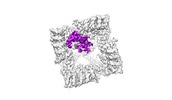
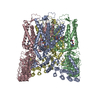

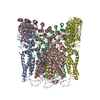


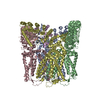
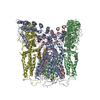

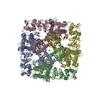
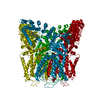




















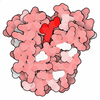

 Z (Sec.)
Z (Sec.) Y (Row.)
Y (Row.) X (Col.)
X (Col.)






















